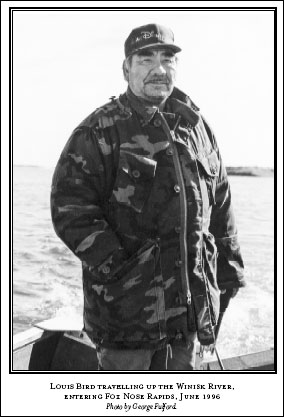
|
|
| Speaker(s): |
Louis Bird |
| Year Recorded: |
January 9, 1989 |
| Transcribers: |
Justin Dyck, Anne Lindsay; editing by Tanja Hutter. This audio clip originally appears on OurVoices.ca under the title 051 - Fish Trapping and Caribou Hunting.
L'audio en français n'est pas disponible. |
| Location: |
Recorded in English, in Peawanuck, Ontario |
| Copyright Holder: |
Louis Bird & University of Winnipeg (OurVoices.ca). Photo: George Fulford |
Listen To Audio File: Part I
|
|
|
Good morning. Good morning [laughing]. My name is Louis Bird and this is January, eighth no, ninth. January Ninth, 1989. This tape recording has to go about, talking about, making a documentary about the Cree people in Hudson Bay. Especially in the Winisk, Winisk band. Winisk band mean is a, a group of people that lived, that have lived in Winisk River, the branch the tributaries of Winisk River, and also North and East. North-West and North-East from the mouth of the Winisk River, along the Hudson Bay coast.
These people, they belong to what they call Winisk Band. They have lived here a long time before the white man came in, and they have their own life, they have their own skills to survive on the land, and they had a method of hunting, and they were a migrating people. Migrating people means following the season, as the animals move around in different seasons. Before the white man, these people live on the coast in summer time to stay away from the flies, and also to hunt the waterfowl, which mean ducks and all that, while they are moving, because ducks and other different kind of ducks usually have their geese or ducklings along the coast of Hudson Bay or James Bay.
So that’s why the Cree people usually go hunting in the bay area, besides trying to stay away from the flies, mosquitoes, and all kinds. And another reason is that they, the Cree people, know the moose and caribou and other big animals will go into the coastal areas because of the same reason, to stay away from the flies. The flies we call bull flies, drive caribous crazy. So the caribous will go into the bay right up to the tide water and stay out there to wash those flies off their body and also live around there where the wind is strong, so not too many flies bother them. For that reason the Cree people used to live right close to the bay, in summer time, and starting from there, in the summer time we can move on to the fall.
When the flies are starting to diminish, like mosquitoes and sand flies, so the Native people start to move inland, because by this time the inland (up the rivers) mosquitoes and other flies are mostly gone. So they start to move inland, the Native people, the Cree people from Winisk River. They go up as far as two hundred miles, most, some of them. Some of them drop along the way, and they leave in September, they leave the mouth of the river to go up and find the wintering camp, where they will winterize. So it’s those wintering camps they choose, they usually choose the creeks, the ones that branch off the main Winisk River, and they choose this spot because they know the fish will come down the river before January, during those two months. And they choose these places where they know where most fish will come down into the main river.
So they choose that and they also set up a fish trap—that is the important thing. They choose the river to set a fish trap which will supply them with food, and also for other reasons. They eat the fish, they smoke them to preserve them at the beginning, and when it start to freeze, they just freeze them right directly from the water into the cache, and all these fish they, they pile them and cash them, and it last them all winter, and that’s their main diet during the winter time, when animals are scarce or things like that. When there’s no rabbits whatsoever. So it was one of the most important things for the Cree people to do. So that was the idea about telling the story about the Cree people, not only one family, but a whole bunch of Cree people who have lived here. There were mostly about twenty families who lived in Winisk River system.
Not all of them go down the bay during the summer, some of them stay on the river or half-way up at the headwaters, whichever, wherever the hunting area is good. And, when the European came in, when the white men came in, they chose Winisk River, the mouth of the river to set up as an outpost trading camp, they considered it this time, from Fort Severn.
Other
Related Material
Learn more about the aboriginal people who helped establish the HBC - enter "Louis Bird" in the search box to your left.
Who is Louis Bird?
Visit OurVoices.ca - for more stories (beyond the fur trade) by Louis Bird, available in Cree and English.
|
Did
You Know?
River basins were closely associated with group identities and territorial organization within the larger Lowland Cree population. For instance, the Severn River Lowland Cree were called Washeo Sepee Indians, after the Cree word for the Severn River.
|
|